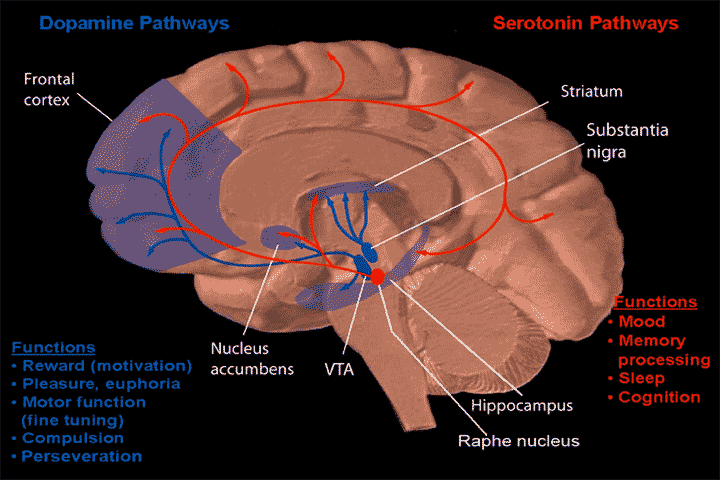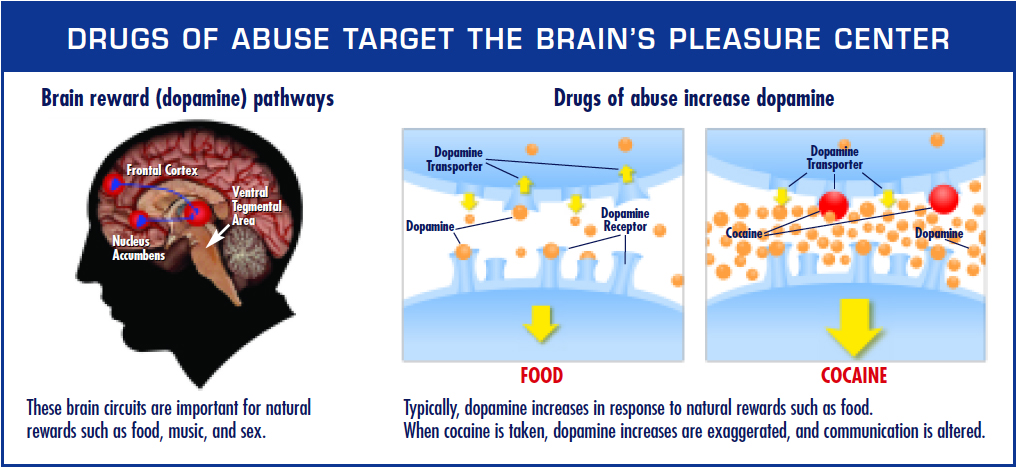The Neuroscience of Addiction
Different addictions tend to alter the function of different neurotransmitters. There is a lot of overlap, particularly among dopamine and the reward pathways in the brain, but some addictions act on completely different neural mechanisms. Some of these pathways and their associated addictions are listed in the table below.
| Neurotransmitter/Mechanism | Functions and Processes | Disruptive Addictions |
| Dopamine | Reward, Motivation, Pleasure | Alcohol, Sugar, Exercise, Gambling, Gaming, Sex and Porn |
| Serotonin | Mood, Social Behavior, Appetite, Sleep, Memory, Libido | Alcohol, Body Modification |
| Glutamate/GABA | Neural Excitation and Inhibition | Alcohol |
| Endogenous Opioids/Endorphins | Pain and Stress Relief, Reward | Alcohol, Body Modification, Exercise |
| Adenosine | Sleep and Arousal | Caffeine |
| Noradrenergic System | Heart rate | Study Drugs |
Some of the brain regions that are impacted by these neurotransmitters and addictions are highlighted below as well.
| Brain Region | Function | Related Neurotransmitters |
| Ventral Tegmental Area | Dopamine Synthesis | Dopamine, GABA, Glutamate, Serotonin |
| Nucleus Accumbens | Dopamine Synthesis | Dopamine, Serotonin |
| Amygdala | Emotional Processing | Dopamine, Opioids |
| Hippocampus | Memory Formation, Learning | Dopamine, Opioids |
Because most of these addictions are related to dopamine function, it’s important to note how dopamine acts on various regions of the brain as well as how dopamine pathways interact with other neurotransmitters to cause addiction.
The Dopamine pathway and its interaction with Serotonin and Noradrenaline

The mesolimbic dopamine pathway projects from the ventral tegmental area to the nucleus accumbens, frontal cortex, and amygdala. Stimulants, including sugar, inhibit the synaptic reuptake of dopamine in this system, causing an excessive amount of dopamine in the nucleus accumbens (1). Stimulants also inhibit reuptake of serotonin and noradrenaline. This inhibition leads to reinforced behavior that may turn into addiction. Opiates also increase dopamine levels in the nucleus accumbens. However, opiate addiction continues even after the dopaminergic pathway to the nucleus accumbens is destroyed, indicating that it is also reinforced by dopamine activity in the ventral tegmental area (2).
Reinforcement in the Dopamine Pathway
Addicts often become conditioned to associate certain conditions, such as objects or locations that are associated with their addiction to the addiction itself. This learned adaptation is due to activation of the mesolimbic dopaminergic system and thus the amygdala during the feeling of engaging in the addictive behavior while also observing the specific context (2).

Dopamine Withdrawal
The mesolimbic dopamine pathway, which is triggered by rewarding behaviors, is regularly activated by addictions. To cope with the excessive activation that these behaviors or substances induce, the body desensitizes itself. Essentially, the brain recognizes that it’s being overstimulated, so it adapts in such a way that stronger signals are now required. Thus, the dopamine levels triggered by the addiction become the baseline. This means that the behavior or substance is now necessary just for the addict to feel normal. If the addict cuts themself off, then their dopamine levels will fall beneath their newly-defined baseline levels. This deficit is what causes the negative feelings of withdrawal (2).
Interactions between Dopamine and both GABA and Serotonin
It’s important to note that these neurotransmitter systems often interact with each other, creating a greater effect than their individual mechanisms do on their own. For example, chronic exposure to alcohol impairs the dopaminergic and GABAergic systems that control the addict’s desire to keep drinking. This mechanism, related to the central amygdala, is regulated by both neurotransmitters rather than either one individually (2).
Alcohol also causes a reduction of activity in the GABAergic system that controls the dopamine circuit in the ventral tegmental area, causing an increase in dopamine levels that leads to an increase in alcohol consumption. It’s notable that a simultaneous increase in serotonin levels will decrease alcohol consumption. This shows how many neurotransmitters are simultaneously involved in addiction, particularly how serotonin and dopamine have opposite effects regarding substance abuse. (2).

